Tall, well-built and ruggedly handsome American actor Charlton Heston (1923-2008) appeared in 100 Hollywood films over 60 years. With features chiselled in stone, he became famous for playing a long list of historical figures in Biblical epics. For Ben-Hur (1959), he won the Academy Award for Best Actor,
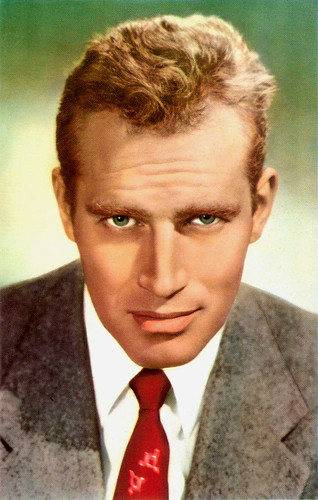
Israelian postcard by Editions de Luxe.

French postcard by E.D.U.G., presented by Corvisart, Epinal, no. 252. Photo: Charlton Heston in Ben-Hur (William Wyler, 1959).

French postcard by E.D.U.G., no. 125. Photo: publicity still for Ben-Hur (William Wyler, 1959).
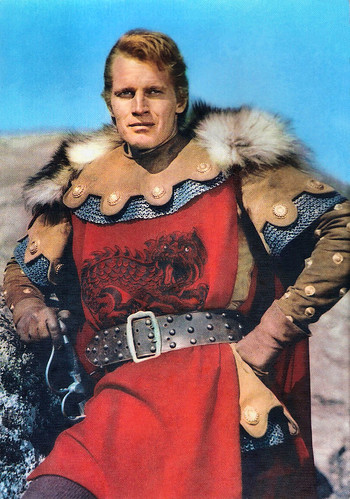
Italian postcard by Rotalcolor, Milano, no. N. 173. Photo: publicity still for El Cid (Anthony Mann, 1961).

Italian postcard. Photo: Dear Film. Charlton Heston, Laurence Olivier and Richard Johnson in Khartoum (Basil Dearden, Eliot Elisofon, 1965).
Charlton Heston was born John Charles Carter in 1924, in Wilmette, Illinois, U.S., to Lila née Baines and Russell Whitford Carter, who operated a sawmill. He had English and Scottish ancestry, with recent Canadian forebears. When Heston was 10 years old, his parents divorced after having three children. Shortly thereafter, his mother remarried Chester Heston. Charlton and his younger sister Lilla and brother Alan attended New Trier High School in Wilmette. During high school, he enrolled in New Trier's drama program, playing the lead role in a 16mm production of Peer Gynt (1941), based on the Henrik Ibsen play. It was directed by future film activist David Bradley. From the Winnetka Community Theatre in which he was active, he earned a drama scholarship to Northwestern University; among his acting teachers was Alvina Krause. In 1944, Heston married Northwestern University student Lydia Marie Clarke, who was six months his senior. That same year he enlisted in the United States Army Air Forces. He served for two years as a radio operator and aerial gunner aboard a B-25 Mitchell stationed in the Alaskan Aleutian Islands with the 77th Bombardment Squadron of the Eleventh Air Force. He reached the rank of Staff Sergeant.
After the war, the Hestons lived in Hell's Kitchen, New York City. Heston made ends meet by posing as a model in New York at The Art Students League, across from Carnegie Hall. Seeking a way to make it in theatre, the couple decided to manage a playhouse in Asheville, North Carolina, in 1947, making $100 a week. In 1948, they returned to New York, where Heston was offered a supporting role in a Broadway revival of William Shakespeare's 'Antony and Cleopatra', starring Katharine Cornell. In television, Heston played several roles in CBS's Studio One, one of the most popular anthology dramas of the 1950s. These included a part as Marc Antony in a televised production of Julius Caesar (1950). He was unable to use his real name, John Carter as an actor because it bore too close a resemblance to the name of the hero in Edgar Rice Burroughs' novel 'Princess of Mars'. His professional name Charlton Heston came from a combination of Charlton, his maternal grandmother Marian's maiden name, and his stepfather's last name.
Film producer Hal B. Wallis of Casablanca (Michael Curtiz, 1942) spotted Heston in a 1950 television production of Wuthering Heights and offered him a contract. When his wife reminded Heston they had decided to pursue theatre and television, he replied, "Well, maybe just for one film to see what it's like." In 1950, he made his feature film debut in the Film Noir Dark City (William Dieterle, 1950) opposite Lizabeth Scott and Viveca Lindfors. Bosley Crowther, film critic for The New York Times, applauded the work of the newcomer: "A new star named Charlton Heston — a tall, tweedy, rough-hewn sort of chap who looks like a triple-threat halfback on a midwestern college football team—is given an unfortunate send-off on the low and lurid level of crime in Hal Wallis' thriller, Dark City, which came to the Paramount yesterday. Apparently, Mr. Heston, who has worked for the stage and video, has something more than appearance to recommend him to dramatic roles. He has a quiet but assertive magnetism, a youthful dignity and a plainly potential sense of timing that is the good actor's sine qua non. But in this 'clutching hand' chiller, he is called upon to play nothing more complex or demanding than a crooked gambler marked for doom."
Heston's breakthrough came when Cecil B. DeMille cast him as circus manager 'Brad Braden' in the spectacular epic The Greatest Show on Earth (Cecil B. DeMille, 1952), also starring James Stewart and Cornel Wilde. The film was named by the Motion Picture Academy as the Best Picture of 1952. It was also the most popular film of that year. The now very popular actor remained perpetually busy during the next years, both on TV and in the cinema. King Vidor used Heston in a melodrama with Jennifer Jones, Ruby Gentry (1952). He pleased audiences again in the steamy thriller Marabunta (Byron Haskin, 1954) with Eleanor Parker, and as a treasure hunter in Secret of the Incas (Jerry Hopper, 1954). Shot on location at Machu Picchu in Peru, the film is often credited as the inspiration for Raiders of the Lost Ark (Steven Spielberg, 1981). Heston became an icon for portraying Moses in the blockbuster The Ten Commandments (Cecil B. DeMille, 1956). According to DeMille, Heston bore an uncanny resemblance to the statue of Moses carved by Michelangelo. The Hollywood Reporter described him as "splendid, handsome and princely (and human) in the scenes dealing with him as a young man, and majestic and terrible as his role demands it". For his role, Heston received his first Golden Globe Award nomination.
Furthermore, he is known for his dynamic Mexican narcotics officer Miguel 'Mike' Vargas in Orson Welles' widely acclaimed Film Noir Touch of Evil (Orson Welles, 1958), and for his rare supporting role alongside Gregory Peck in the Western The Big Country (William Wyler, 1958). Then followed his best-known role as the wronged Jewish prince who seeks his freedom and revenge in Ben-Hur (William Wyler, 1959), for which he won the Oscar for Best Actor. It was one of the unprecedented 11 Oscars the film earned. This Biblical epic became the standard by which other large-scale productions would be judged. Its superb cast also included Stephen Boyd as the villainous Massala, and English actor Jack Hawkins as the Roman officer Quintus Arrius.
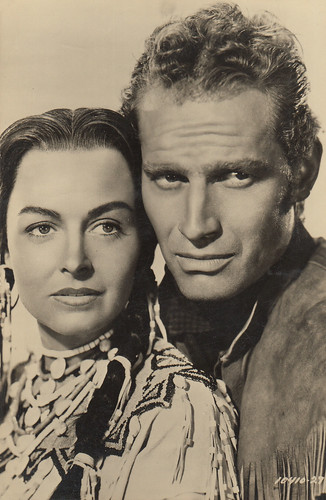
Spanish postcard by Archivo Bermejo, no. 7174. Donna Reed as Native American character Sacajawea and Charlton Heston in The Far Horizons (Rudolph Maté, 1955). Collection: Marlene Pilaete.
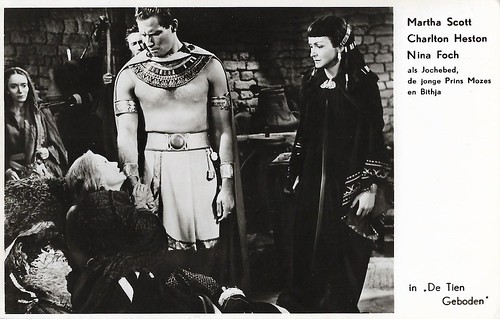
Dutch postcard. Photo: Charlton Heston, Nina Foch, and Martha Scott in The Ten Commandments (Cecil B. DeMille, 1956), released in Dutch as De Tien Geboden.
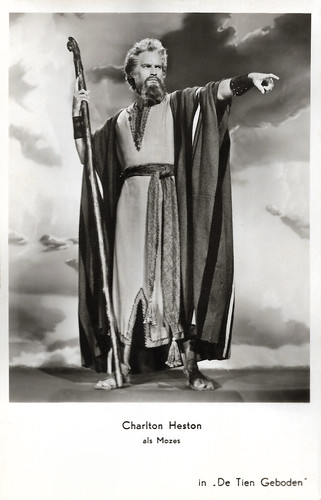
Dutch postcard by Gebr. Spanjersberg N.V., Rotterdam, no. 5183. Photo: Paramount. Publicity still for The Ten Commandments (Cecil B. DeMille, 1956) with Charlton Heston as Moses. Moses' robe was hand-woven by Dorothea Hulse, one of the world's finest weavers. She also created costumes for The Robe, as well as textiles and costume fabrics for Samson and Delilah, David and Bathsheba, and others.

German postcard by Kolibri-Verlag, Minden-Westf., no. 451. Photo: M.G.M. Charlton Heston in Ben-Hur (William Wyler, 1959).

Spanish postcard by Archivo Bern, no. 7249, 1960-1961. Photo: MGM. Marina Berti and Charlton Heston in Ben-Hur (William Wyler, 1959).
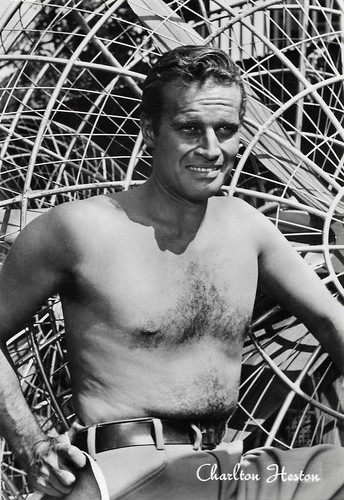
Italian postcard by Rotalfoto, Milano, no. 648.

German postcard by Rüdel-Verlag, Hamburg-Bergedorf, no. 3632. Photo: Rank-Film. Publicity still for El Cid (Anthony Mann, 1961).
During the 1960s, Charlton Heston remained the preferred choice of many directors to lead the cast in major historical productions. These starring roles gave the actor a grave, authoritative persona and embodied responsibility, individualism and masculinity. Heston rejected scripts that did not emphasise those virtues. He starred as Spanish legend Rodrigo Diaz de Vivar in El Cid (Anthony Mann, 1961), opposite Sophia Loren. The film, shot in Spain, was a big success. Heston was a US soldier battling hostile Chinese boxers during 55 Days at Peking (Nicholas Ray, 1963) with Ava Gardner, played the ill-fated John the Baptist in The Greatest Story Ever Told (George Stevens, 1965), painter Michelangelo battling Pope Julius II (Rex Harrison) in The Agony and the Ecstasy (Carol Reed, 1965), and an English general in Khartoum (Basil Dearden, 1966) opposite Laurence Olivier.
Heston liked the Western genre. In 1968, Heston filmed the unusual western Will Penny (Tom Gries, 1968) about an ageing and lonely cowboy befriending a lost woman (Joan Hackett) and her son. The picture was based upon an episode of the 1960 Sam Peckinpah television series The Westerner called Line Camp, also written and directed by Tom Gries. The film was not a box office hit but received excellent reviews. Heston referred to the film as his favourite piece of work on screen. Interestingly, Heston was on the verge of acquiring an entirely new league of fans due to his appearance in four very topical Science Fiction films (all based on popular novels) painting bleak futures for mankind. In 1968, Heston starred as time-traveling astronaut George Taylor, in the terrific Planet of the Apes (Franklin J. Schaffner, 1968) with its now legendary conclusion as Heston realises the true horror of his destination. He returned to reprise the role, albeit primarily as a cameo, alongside fellow astronaut James Franciscus in the slightly inferior sequel Beneath the Planet of the Apes (Ted Post, 1970).
Next up, Heston again found himself facing the apocalypse in The Omega Man (Boris Sagal, 1971) as the survivor of a germ plague that has wiped out humanity leaving only bands of psychotic lunatics roaming the cities who seek to kill the uninfected Heston. And fourthly, taking its inspiration from the Harry Harrison novel 'Make Room!, Make Room!', Heston starred alongside screen legend Edward G. Robinson and Chuck Connors in Soylent Green (Richard Fleischer, 1973). During the remainder of the 1970s, Heston appeared in two very popular Disaster films contributing lead roles in the far-fetched Airport 1975 (Jack Smight, 1974), plus in the star-laden Earthquake (Mark Robson, 1974), filmed in Sensurround (low bass speakers were installed in selected theatres to simulate the earthquake rumblings on screen to film audiences). Heston played the evil Cardinal Richelieu in the lively The Three Musketeers (Richard Lester, 1973) and the sequel The Four Musketeers (Richard Lester, 1974), starring Michael York and Oliver Reed. He was a mythical US naval officer in the recreation of Battle of Midway (1976), also filmed in Sensurround, an LA cop trying to stop a sniper in Two-Minute Warning (Larry Peerce, 1976) and another US naval officer in the submarine thriller Gray Lady Down (David Greene, 1978).
Heston appeared in numerous episodes of the high-rating TV series Dynasty (1981) and The Colbys (1985), before moving onto a mixed bag of projects including TV adaptations of A Man for All Seasons (Charlton Heston, 1988) with Vanessa Redgrave and John Gielgud, and Treasure Island (Fraser Clarke Heston, 1990) with Christian Bale, and hosting two episodes of the comedy show, Saturday Night Live (1975). In the cinema he appeared in cameos as the Good Actor bringing love-struck Mike Myers to tears in Wayne's World 2 (Stephen Surjik, 1993), and as the eyepatch-wearing boss of intelligence agent Arnold Schwarzenegger in True Lies (James Cameron, 1994). Heston was a supporter of Democratic politicians and civil rights in the 1960s and volunteered his time and effort to the Civil Rights movement. He even marched alongside the Rev. Dr. Martin Luther King Jr. on several occasions, including the 1963 March on Washington. Eventually, he rejected liberalism and founded a conservative political action committee.
Heston campaigned for Republican presidential candidates Ronald Reagan in 1984, George Bush in 1988, George W. Bush in 2000, and Republican candidate for governor of Virginia George Allen in 1993. He was president of the Screen Actors Guild from 1966 to 1971. Heston's most famous role in politics came as the five-term president of the National Rifle Association from 1998 to 2003. Though often portrayed as an ultra-conservative, Heston wrote in his 1995 autobiography 'In the Arena' that he was opposed to the McCarthy witch hunts of the 1950s, was against the Vietnam War and thought President Richard Nixon was bad for America. In 2001, Heston made a cameo appearance as Gen. Thade's father, an elderly, dying chimpanzee in Tim Burton's remake of Planet of the Apes (2001). His last film appearance was as the infamous Nazi war criminal Dr. Josef Mengele in the Holocaust-themed drama My Father, Rua Alguem 5555 (Egidio Eronico, 2003) with Thomas Kretschmann as his son. In 2002, Charlton Heston was diagnosed with Alzheimer's disease. A frail-looking Heston was presented with a Presidential Medal of Freedom, the nation's highest civilian award, at the White House by George W. Bush in July 2003. He died in 2008. Heston and his wife Lydia had two children, director Fraser C. Heston and Holly Heston Rochell.

French postcard by Editions P.I., offered by Les Carbones Korès 'Carboplane', no. 593. Photo: Paramount, 1953.

British postcard in the Picturegoer Series, London, no. D 145. Photo: Paramount.

British postcard in the Picturegoer Series, London, no. D 506. Photo: Columbia.
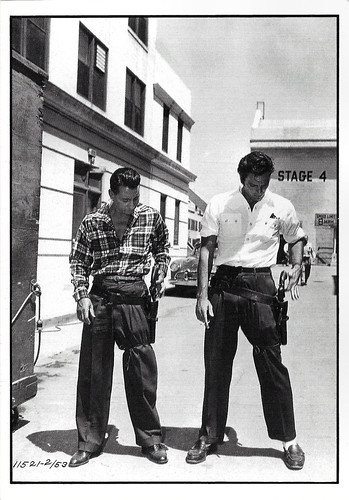
French postcard in the Entr'acte series by Éditions Asphodèle, Mâcon, no. 004/11. Collection: B. Courtel / D.R. Charlton Heston (right) on the set of Three Violent People (Rudolph Maté, 1957). Caption: Dressing up and carrying weapons! Training session for Charlton Heston between two sets at Paramount Studios.

Spanish card, 2004. Photo: Paramount. Charlton Heston in The Ten Commandments (Cecil B. DeMille, 1956).

German postcard by ISV, no. E 29. Photo: MGM. Publicity still for Ben-Hur (William Wyler, 1959).

Dutch postcard, no. 143. Photo: publicity still for El Cid (Anthony Mann, 1961).
Sources: Wikipedia and IMDb.
This post was last updated on 12 September 2024.

Israelian postcard by Editions de Luxe.

French postcard by E.D.U.G., presented by Corvisart, Epinal, no. 252. Photo: Charlton Heston in Ben-Hur (William Wyler, 1959).

French postcard by E.D.U.G., no. 125. Photo: publicity still for Ben-Hur (William Wyler, 1959).

Italian postcard by Rotalcolor, Milano, no. N. 173. Photo: publicity still for El Cid (Anthony Mann, 1961).

Italian postcard. Photo: Dear Film. Charlton Heston, Laurence Olivier and Richard Johnson in Khartoum (Basil Dearden, Eliot Elisofon, 1965).
A tall, tweedy, rough-hewn sort of chap
Charlton Heston was born John Charles Carter in 1924, in Wilmette, Illinois, U.S., to Lila née Baines and Russell Whitford Carter, who operated a sawmill. He had English and Scottish ancestry, with recent Canadian forebears. When Heston was 10 years old, his parents divorced after having three children. Shortly thereafter, his mother remarried Chester Heston. Charlton and his younger sister Lilla and brother Alan attended New Trier High School in Wilmette. During high school, he enrolled in New Trier's drama program, playing the lead role in a 16mm production of Peer Gynt (1941), based on the Henrik Ibsen play. It was directed by future film activist David Bradley. From the Winnetka Community Theatre in which he was active, he earned a drama scholarship to Northwestern University; among his acting teachers was Alvina Krause. In 1944, Heston married Northwestern University student Lydia Marie Clarke, who was six months his senior. That same year he enlisted in the United States Army Air Forces. He served for two years as a radio operator and aerial gunner aboard a B-25 Mitchell stationed in the Alaskan Aleutian Islands with the 77th Bombardment Squadron of the Eleventh Air Force. He reached the rank of Staff Sergeant.
After the war, the Hestons lived in Hell's Kitchen, New York City. Heston made ends meet by posing as a model in New York at The Art Students League, across from Carnegie Hall. Seeking a way to make it in theatre, the couple decided to manage a playhouse in Asheville, North Carolina, in 1947, making $100 a week. In 1948, they returned to New York, where Heston was offered a supporting role in a Broadway revival of William Shakespeare's 'Antony and Cleopatra', starring Katharine Cornell. In television, Heston played several roles in CBS's Studio One, one of the most popular anthology dramas of the 1950s. These included a part as Marc Antony in a televised production of Julius Caesar (1950). He was unable to use his real name, John Carter as an actor because it bore too close a resemblance to the name of the hero in Edgar Rice Burroughs' novel 'Princess of Mars'. His professional name Charlton Heston came from a combination of Charlton, his maternal grandmother Marian's maiden name, and his stepfather's last name.
Film producer Hal B. Wallis of Casablanca (Michael Curtiz, 1942) spotted Heston in a 1950 television production of Wuthering Heights and offered him a contract. When his wife reminded Heston they had decided to pursue theatre and television, he replied, "Well, maybe just for one film to see what it's like." In 1950, he made his feature film debut in the Film Noir Dark City (William Dieterle, 1950) opposite Lizabeth Scott and Viveca Lindfors. Bosley Crowther, film critic for The New York Times, applauded the work of the newcomer: "A new star named Charlton Heston — a tall, tweedy, rough-hewn sort of chap who looks like a triple-threat halfback on a midwestern college football team—is given an unfortunate send-off on the low and lurid level of crime in Hal Wallis' thriller, Dark City, which came to the Paramount yesterday. Apparently, Mr. Heston, who has worked for the stage and video, has something more than appearance to recommend him to dramatic roles. He has a quiet but assertive magnetism, a youthful dignity and a plainly potential sense of timing that is the good actor's sine qua non. But in this 'clutching hand' chiller, he is called upon to play nothing more complex or demanding than a crooked gambler marked for doom."
Heston's breakthrough came when Cecil B. DeMille cast him as circus manager 'Brad Braden' in the spectacular epic The Greatest Show on Earth (Cecil B. DeMille, 1952), also starring James Stewart and Cornel Wilde. The film was named by the Motion Picture Academy as the Best Picture of 1952. It was also the most popular film of that year. The now very popular actor remained perpetually busy during the next years, both on TV and in the cinema. King Vidor used Heston in a melodrama with Jennifer Jones, Ruby Gentry (1952). He pleased audiences again in the steamy thriller Marabunta (Byron Haskin, 1954) with Eleanor Parker, and as a treasure hunter in Secret of the Incas (Jerry Hopper, 1954). Shot on location at Machu Picchu in Peru, the film is often credited as the inspiration for Raiders of the Lost Ark (Steven Spielberg, 1981). Heston became an icon for portraying Moses in the blockbuster The Ten Commandments (Cecil B. DeMille, 1956). According to DeMille, Heston bore an uncanny resemblance to the statue of Moses carved by Michelangelo. The Hollywood Reporter described him as "splendid, handsome and princely (and human) in the scenes dealing with him as a young man, and majestic and terrible as his role demands it". For his role, Heston received his first Golden Globe Award nomination.
Furthermore, he is known for his dynamic Mexican narcotics officer Miguel 'Mike' Vargas in Orson Welles' widely acclaimed Film Noir Touch of Evil (Orson Welles, 1958), and for his rare supporting role alongside Gregory Peck in the Western The Big Country (William Wyler, 1958). Then followed his best-known role as the wronged Jewish prince who seeks his freedom and revenge in Ben-Hur (William Wyler, 1959), for which he won the Oscar for Best Actor. It was one of the unprecedented 11 Oscars the film earned. This Biblical epic became the standard by which other large-scale productions would be judged. Its superb cast also included Stephen Boyd as the villainous Massala, and English actor Jack Hawkins as the Roman officer Quintus Arrius.

Spanish postcard by Archivo Bermejo, no. 7174. Donna Reed as Native American character Sacajawea and Charlton Heston in The Far Horizons (Rudolph Maté, 1955). Collection: Marlene Pilaete.

Dutch postcard. Photo: Charlton Heston, Nina Foch, and Martha Scott in The Ten Commandments (Cecil B. DeMille, 1956), released in Dutch as De Tien Geboden.

Dutch postcard by Gebr. Spanjersberg N.V., Rotterdam, no. 5183. Photo: Paramount. Publicity still for The Ten Commandments (Cecil B. DeMille, 1956) with Charlton Heston as Moses. Moses' robe was hand-woven by Dorothea Hulse, one of the world's finest weavers. She also created costumes for The Robe, as well as textiles and costume fabrics for Samson and Delilah, David and Bathsheba, and others.

German postcard by Kolibri-Verlag, Minden-Westf., no. 451. Photo: M.G.M. Charlton Heston in Ben-Hur (William Wyler, 1959).

Spanish postcard by Archivo Bern, no. 7249, 1960-1961. Photo: MGM. Marina Berti and Charlton Heston in Ben-Hur (William Wyler, 1959).

Italian postcard by Rotalfoto, Milano, no. 648.

German postcard by Rüdel-Verlag, Hamburg-Bergedorf, no. 3632. Photo: Rank-Film. Publicity still for El Cid (Anthony Mann, 1961).
Embodying responsibility, individualism and masculinity
During the 1960s, Charlton Heston remained the preferred choice of many directors to lead the cast in major historical productions. These starring roles gave the actor a grave, authoritative persona and embodied responsibility, individualism and masculinity. Heston rejected scripts that did not emphasise those virtues. He starred as Spanish legend Rodrigo Diaz de Vivar in El Cid (Anthony Mann, 1961), opposite Sophia Loren. The film, shot in Spain, was a big success. Heston was a US soldier battling hostile Chinese boxers during 55 Days at Peking (Nicholas Ray, 1963) with Ava Gardner, played the ill-fated John the Baptist in The Greatest Story Ever Told (George Stevens, 1965), painter Michelangelo battling Pope Julius II (Rex Harrison) in The Agony and the Ecstasy (Carol Reed, 1965), and an English general in Khartoum (Basil Dearden, 1966) opposite Laurence Olivier.
Heston liked the Western genre. In 1968, Heston filmed the unusual western Will Penny (Tom Gries, 1968) about an ageing and lonely cowboy befriending a lost woman (Joan Hackett) and her son. The picture was based upon an episode of the 1960 Sam Peckinpah television series The Westerner called Line Camp, also written and directed by Tom Gries. The film was not a box office hit but received excellent reviews. Heston referred to the film as his favourite piece of work on screen. Interestingly, Heston was on the verge of acquiring an entirely new league of fans due to his appearance in four very topical Science Fiction films (all based on popular novels) painting bleak futures for mankind. In 1968, Heston starred as time-traveling astronaut George Taylor, in the terrific Planet of the Apes (Franklin J. Schaffner, 1968) with its now legendary conclusion as Heston realises the true horror of his destination. He returned to reprise the role, albeit primarily as a cameo, alongside fellow astronaut James Franciscus in the slightly inferior sequel Beneath the Planet of the Apes (Ted Post, 1970).
Next up, Heston again found himself facing the apocalypse in The Omega Man (Boris Sagal, 1971) as the survivor of a germ plague that has wiped out humanity leaving only bands of psychotic lunatics roaming the cities who seek to kill the uninfected Heston. And fourthly, taking its inspiration from the Harry Harrison novel 'Make Room!, Make Room!', Heston starred alongside screen legend Edward G. Robinson and Chuck Connors in Soylent Green (Richard Fleischer, 1973). During the remainder of the 1970s, Heston appeared in two very popular Disaster films contributing lead roles in the far-fetched Airport 1975 (Jack Smight, 1974), plus in the star-laden Earthquake (Mark Robson, 1974), filmed in Sensurround (low bass speakers were installed in selected theatres to simulate the earthquake rumblings on screen to film audiences). Heston played the evil Cardinal Richelieu in the lively The Three Musketeers (Richard Lester, 1973) and the sequel The Four Musketeers (Richard Lester, 1974), starring Michael York and Oliver Reed. He was a mythical US naval officer in the recreation of Battle of Midway (1976), also filmed in Sensurround, an LA cop trying to stop a sniper in Two-Minute Warning (Larry Peerce, 1976) and another US naval officer in the submarine thriller Gray Lady Down (David Greene, 1978).
Heston appeared in numerous episodes of the high-rating TV series Dynasty (1981) and The Colbys (1985), before moving onto a mixed bag of projects including TV adaptations of A Man for All Seasons (Charlton Heston, 1988) with Vanessa Redgrave and John Gielgud, and Treasure Island (Fraser Clarke Heston, 1990) with Christian Bale, and hosting two episodes of the comedy show, Saturday Night Live (1975). In the cinema he appeared in cameos as the Good Actor bringing love-struck Mike Myers to tears in Wayne's World 2 (Stephen Surjik, 1993), and as the eyepatch-wearing boss of intelligence agent Arnold Schwarzenegger in True Lies (James Cameron, 1994). Heston was a supporter of Democratic politicians and civil rights in the 1960s and volunteered his time and effort to the Civil Rights movement. He even marched alongside the Rev. Dr. Martin Luther King Jr. on several occasions, including the 1963 March on Washington. Eventually, he rejected liberalism and founded a conservative political action committee.
Heston campaigned for Republican presidential candidates Ronald Reagan in 1984, George Bush in 1988, George W. Bush in 2000, and Republican candidate for governor of Virginia George Allen in 1993. He was president of the Screen Actors Guild from 1966 to 1971. Heston's most famous role in politics came as the five-term president of the National Rifle Association from 1998 to 2003. Though often portrayed as an ultra-conservative, Heston wrote in his 1995 autobiography 'In the Arena' that he was opposed to the McCarthy witch hunts of the 1950s, was against the Vietnam War and thought President Richard Nixon was bad for America. In 2001, Heston made a cameo appearance as Gen. Thade's father, an elderly, dying chimpanzee in Tim Burton's remake of Planet of the Apes (2001). His last film appearance was as the infamous Nazi war criminal Dr. Josef Mengele in the Holocaust-themed drama My Father, Rua Alguem 5555 (Egidio Eronico, 2003) with Thomas Kretschmann as his son. In 2002, Charlton Heston was diagnosed with Alzheimer's disease. A frail-looking Heston was presented with a Presidential Medal of Freedom, the nation's highest civilian award, at the White House by George W. Bush in July 2003. He died in 2008. Heston and his wife Lydia had two children, director Fraser C. Heston and Holly Heston Rochell.

French postcard by Editions P.I., offered by Les Carbones Korès 'Carboplane', no. 593. Photo: Paramount, 1953.

British postcard in the Picturegoer Series, London, no. D 145. Photo: Paramount.

British postcard in the Picturegoer Series, London, no. D 506. Photo: Columbia.

French postcard in the Entr'acte series by Éditions Asphodèle, Mâcon, no. 004/11. Collection: B. Courtel / D.R. Charlton Heston (right) on the set of Three Violent People (Rudolph Maté, 1957). Caption: Dressing up and carrying weapons! Training session for Charlton Heston between two sets at Paramount Studios.

Spanish card, 2004. Photo: Paramount. Charlton Heston in The Ten Commandments (Cecil B. DeMille, 1956).

German postcard by ISV, no. E 29. Photo: MGM. Publicity still for Ben-Hur (William Wyler, 1959).

Dutch postcard, no. 143. Photo: publicity still for El Cid (Anthony Mann, 1961).
Sources: Wikipedia and IMDb.
This post was last updated on 12 September 2024.
No comments:
Post a Comment